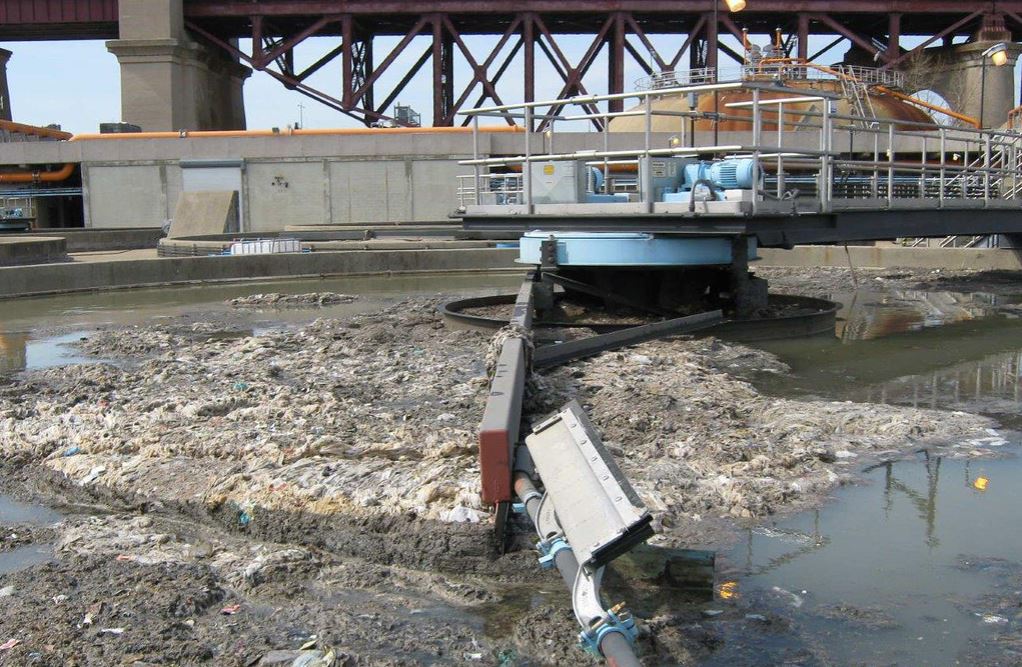
A collection of “flushable” wipes pile up at an NYC water treatment plant. (NYC Department of Environmental Protection)
If you’ve ever had to snake your bathtub and pulled out gobs of hair and miscellaneous goop, you know how gross it can be. Now multiply this scene for an entire city — especially a city the size of New York, whose current population is 8.4 million and you know this is a monster problem. And we don’t mean King Kong or Godzilla.
Enter fatbergs, a cutesy name given to these grease-laden masses of sordid waste that are clogging the city’s sewers. They are wreaking havoc on NYC’s sewage system and are costly to remove. Because of this, the NYC Department of Environmental Protection (DEP) has launched an all-out attack on fatbergs with an awareness and prevention campaign featuring ads in the subway and on TV.
So, What Is a Fatberg?
The term fatberg comes from the combination of “fat” and “iceberg.” Basically they are masses of grease and personal hygiene products that clog sewers here in NYC and elsewhere. You may have seen the hideous photos of a fatberg found in England or this six-foot tall fatberg in Detroit.
“Fortunately we are not pulling out multi-ton fatbergs the size of the London ones,” said Mikelle Adgate, DEP’s senior adviser for strategic planning. “But we are pulling out mini fatbergs of congealed wipes and grease.”
To Flush or Not to Flush?
So, how did New York find itself with a fatberg problem? Mainly, because people are flushing all kinds of unflushable things down the toilet. Just because an item says it’s flushable, doesn’t mean that you should. Products labeled “flushable” just indicate that it will pass your toilet bowl and building’s sewer pipe with ease, but once it’s in the wild west of the NYC sewer system, it will not break down in the same way toilet paper does.
Then, all these thousands of unflushable items congeal together and end up at local water treatment plants where they have to be collected and hauled off to landfills.
Here’s What You Shouldn’t Flush (But People Do)
- Disposable wet wipes for babies (and adults)
- Feminine hygiene products
- Cat litter
- Condoms
- Cotton swabs
- Cooking grease
All of these items should be trashed instead.
Here’s What You Can Flush
The campaign urges New Yorkers to only flush the four Ps: poop, pee, puke and (toilet) paper. While most of us probably don’t flush cooking grease, it gets poured down the drain where it builds up over time, causing blockage and preventing wastewater from getting through. To get rid of cooking grease, the DEP suggests residents place the cooled oil in a sealed container and toss it with your garbage. For more detailed instructions for cooking oil and grease disposal, consult this guide.
“We treat over one billion gallons of wastewater a day,” Adgate explains. “If you’re pouring grease down the sink, it’s not just your plumbing that’s at risk. It causes a full sewer backup.”
See Manhattan Homes Under $700K Article continues below
Wipes and other hygiene products clog equipment at water treatment plants. (NYC Department of Environmental Protection)
Fatbergs Are Not Just Gross, They’re Costly
According to the fatberg campaign site, the city estimates it spends $18.8 million a year to unclog and degrease the sewers, in addition to repairing water treatment plant equipment damage. Although sewer backups are down according to 2018’s State of the Sewers Report, grease build up caused over 75% of the 2,382 reported backups. Repairing a sewer line can cost anywhere from $10,000 to $15,000 — not exactly inexpensive.
So why should you care? Why not just flush whatever you want down the toilet? Because there’s a good chance these costs could be passed on to you. “As New Yorkers, we tend to not think about it as much since many of us rent and don’t directly pay a water bill,” says Adgate. “But homeowners (and landlords) would experience higher water rates and these costs could also be factored into rent.”
Imagine a new line item to your rental costs: First month’s rent, last month’s rent, broker’s fee, security and fatberg maintenance. Ugh.
—
Hoping to find a killer bargain in New York? Whether you’re looking to rent or to buy, search NYC apartments on StreetEasy.